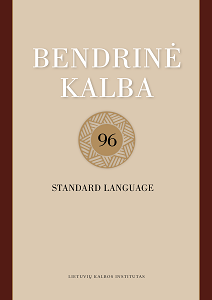Morfologiškai daugiareikšmių formų atsiradimo priežastys
The Reasons for the Morphologically Ambiguos Forms
Author(s): Miglė ŽemrietėSubject(s): Language studies, Theoretical Linguistics, Morphology, Lexis, Baltic Languages
Published by: Lietuvių Kalbos Institutas
Keywords: morphological ambiguity; automatic morphological analysis; corpus; homoforms; dictionary;
Summary/Abstract: In the article, the reasons for the homoforms of the Lithuanian language are described on the basis of data obtained from the Dictionary of Homoforms of the Lithuanian Language. The author offers a classification of homoforms according to the reasons of their appearance, which is as follows: homoforms that are more theoretical in nature and appeared due to the specifics of creating dictionaries; homoforms resulting from differences in prosodic elements; homoforms resulting from different overlapping words; homoforms that arose due to the specifics of the Lithuanian morphology system; homoforms of the same meaning that appeared under different paradigms. These reasons help us to understand why annotation by morphological annotators often result in different cases of morphological ambiguity.
Journal: Bendrinė kalba (iki 2014 metų – Kalbos kultūra)
- Issue Year: 2023
- Issue No: 96
- Page Range: 107-137
- Page Count: 31
- Language: Lithuanian

